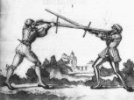Reinhard, did you see there are some German manuals too...probably in "olde" German.
War hammers tend to be used against armor so you would see them in knightly combat, which tends to require some expensive equipment- and literacy would probably be common in that group. Historical hammers tend to be either one or two handed and spiked like a pick on one side, with a hammer face or small prongs on the other. And they were lighter than you might think. Same with the swords...Those two handed swords probably weigh in at about 7-9 pounds. The Scottish Claymore which was also two handed but shorter was only about 5-6 pounds! They are not actually very heavy but the leverage is an issue. They are a lot longer than a sledgehammer of the same weight.
This is a weapon called a bec de corbin, pretty much the pinnacle of warhammer evolution and a really good can opener. You can see it can be used in several ways. This is a two handed weapon but still probably only weighs about 6-8 pounds. Heavy weapons mean you can't strike and defend quickly or for as long.

Peasants would just fight with farm tools. So you may well have had the ancient sledgehammer itself used. But I doubt they had any sort of martial systems for it.

Not many pictures in it but this manual concerns poleaxes/hammers/picks all pretty similar in use.
http://www.thearma.org/spotlight/lejeudelahache.htm
